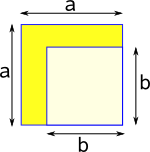A quadratic function has an x² term, its general form is:
a x² + b x + c = 0
A quadratic equation is one in which the unknown is in the second degree. Usually a quadratic has two solutions or roots:
eg if:
x² = 36
x = √36
x = +6 or -6
can be written as:
x = ± 6
Methods of solution
- by factors
- by completing the square
- by formulae
- by graph
Factorising
The first step in factorising is to find the highest common factor in expressional terms
4 l² x² - 2 l x3
2 l x² (2 l - x)
Factors of a² - b²
a² - b² = (a+b)(a-b)
This can be used to factorise the difference of any two squares
Factorising
solve the equation
3 x² = 2 x +5
3 x² - 2 x - 5 = 0
(3x - 5)(x+1) =0
so either (3x - 5) =0 or (x+1) =0
so either x = 3/5 or x=-1
completing the square
The basis of this method is the forming of a perfect square, examples of perfect squares are:
- (x+1)² = x² + 2 x + 1
- (x-4)² = x² - 8 x + 16
Consider the equation x² + 10x
To form a perfect square a number is added which is the square of 1/2 the coefiant of x i.e.:
x² + 10x + (10/2)²
= x² + 10x +25
= (x+5) ²
Another example
6 x² + 11 x = 10
first step: divide both sides by the coeficient of x²(ie 6)
6 x² /6 + 11/6 x = 10/6
second step: make a perfect square by adding to both sides the square of 1/2 the coeficient of x ie (11/12) ²
x² + 11/6 x + (11/12) ² = 10/6 + (11/12) ²
(x + 11/12) ² = 136/144
(x + 11/12) =± √(136/144)
x = - 11/12 ± 19/12
x = -30/12 or 8/12
x = -2.5 or 0.667
Solution by formula
if
a x² + b x + c = 0
| then x= | -b ± √(b² - 4ac ) |
2a |
This formula can be proved by following the completing the square method with algebraic constants a,b and c instead of actual numbers:
a x² + b x + c = 0
a x² + b x = -c
x² + b/a x = -c/a
x² + b/a x + (b/2a)² = -c/a + (b/2a)²
(x + b/2a)² = -c/a + b²/4a²
x + b/2a = ± √(-c/a + b²/4a²)
![]()
Types of solution
The solution depends whether:
| b² - 4ac > 0 | two real solutions |
| b² - 4ac = 0 | one solution |
| b² - 4ac < 0 | complex number solutions |
Quadratics with Complex roots
Not every quadratic equation has a solution for real numbers, however there is an algebraic system which has a solution for every quadratic equation, these are the complex numbers.
Consider the following example:
x² - 6x + 10 = 0
from the formula we get:
x = ( 6 ± √(-4) )/2
Since there is no real root to √-4 it is expressed
√(-4) = √2*(-1)
√(-1) is called 'i'
therefore √(-4) = ±2i
therfore the solution to the problem is:
x = 3 ± i
Using Symmetry
Instead of using the equation:
a x² + b x + c = 0
we can use the equation:
(x - x1)*(x - x2) = 0
which has solutions at:
x = x1 and x = x2
where:
x1 + x2 = -b/a
x1 * x2 = c/a
The equation (x - x1)*(x - x2) = 0 is much more symmetrical in that x1and x2can be swapped with each other without changing the result.
solutions are = ((x1 + x2) ± (x1 - x2))/2
where:
- x1 + x2 = -b/a
- x1 - x2 = √((x1 + x2)² - 4(x1 * x2)) = √((b/a)² - 4(c/a))
- x1 * x2 = c/a
Quadratic Equations in Two Variables
We can represent a general quadratic equation in two variables as:
A x² + B xy + C y²+ D x + E y + F = 0
In the same way that the quadratic equation in one variable has different classes of solution (real, complex, etc.) so our quadratic equation in two variables has different types of solution.
| circle | x² + y² = r² | ||||||
| ellipse |
|
||||||
| parabola | y² = 4 a x | ||||||
| hyperbola |
|
These types can all be visualised as conic sections as shown on this page.
Useful Identities
Here are some results which may help to speed up our calculations.
Difference of 2 squares
| a²-b²= | (a+b)(a-b) |
 |
 |
Program
There are a number of open source programs that can solve polynomial equations. I have used Axiom, how to install Axiom here.
To get a numeric solution for a given equation we can use complexSolve as shown here:
complexSolve(3*x^2+4*x+5 = 0,1.e-10)
I have put user input in red:
(1) -> complexSolve(3*x^2+4*x+5 = 0,1.e-10) (1) |
Or we can find a formula for, say, a quadratic equation using radicalSolve as shown here:
(3) -> radicalSolve(a*x^2 + b*x + c = 0,x)
+-----------+ +-----------+
| 2 | 2
- \|- 4a c + b - b \|- 4a c + b - b
(3) [x= --------------------,x= ------------------]
2a 2a
Type: List Equation Expression Integer
|
Code
Here is a Java function to return the quadratic roots
